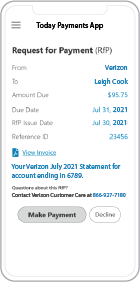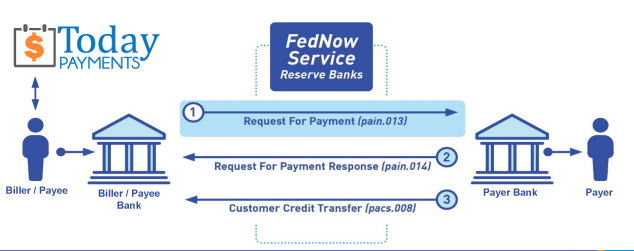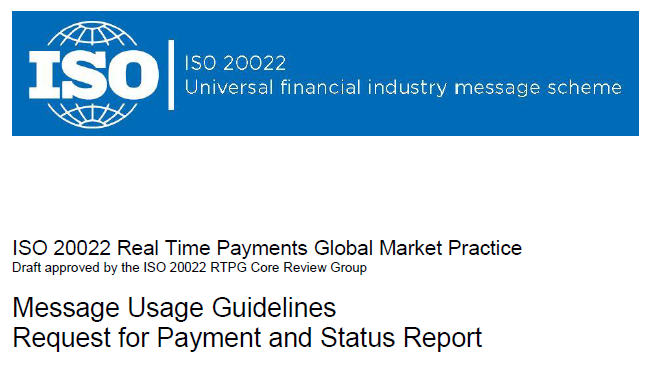
Real-Time Payments (RTP®) and FedNow® Instant Payments
What are Real-time Payments?
Real-Time Payments – Payee-Initiated RfPs
via FedNow® and RTP®
Real-Time Payments empower Payees to
initiate secure, instant transactions through Request for
Payments (RfP) using the FedNow® Service and the RTP®
network. Designed for businesses, merchants, and organizations
of all sizes, this system allows the payee—not just the Payer—to
control the transaction flow with precision, speed, and full
reconciliation visibility.
All transactions are structured using ISO
20022, enabling real-time interoperability across U.S. financial
institutions. With our solution, Payees can request payments
directly from customers via hosted links, email, or mobile—and
receive funds within seconds.
Real-Time Payments Put Payees in Control
In traditional payments, payees must wait
passively while customers process invoices. But with real-time
RfPs, payees initiate the request and receive payment on their
terms—instantly.
Using the structured format of ISO 20022,
each Request for Payment includes all necessary transaction details,
a unique MID tied to the Payee’s alias (email or phone), and a
hosted payment page for the Payer. Payments are routed through
FedNow® or RTP®, depending on availability, with real-time
settlement and confirmation delivered to the Payee’s dashboard.
This system works across all U.S. banks and
credit unions—without requiring a branch visit or manual follow-up.
Benefits of Real-Time Payments (RTP®) and FedNow® Instant Payments
1. Speed and Efficiency-
Transactions are processed in seconds, enabling quick access to funds.
-
Eliminates the need for batch processing or waiting for business hours.
-
Utilizes advanced encryption and fraud detection mechanisms.
-
Reduces the risks associated with check fraud or delayed payments.
-
Unlike traditional bank transfers, RTP® and FedNow® instant payments operate every day of the year, including weekends and holidays.
-
Businesses can better manage their financial operations with instant payment settlements.
-
Reduces dependency on credit lines for liquidity management.
-
Consumers and businesses benefit from faster transactions, leading to enhanced satisfaction and trust.
How Real-Time Payments (RTP®) and FedNow® Instant Payments Work
RTP® and FedNow® instant payments rely on a robust financial infrastructure that connects banks, payment networks, and digital platforms. Here’s how a typical transaction works:
-
Initiation: The sender submits a payment request via a mobile banking app, online portal, or payment gateway.
-
Validation & Security Checks: The payment system verifies the sender’s details, ensures sufficient funds, and checks for fraud risks.
-
Transaction Processing: The payment is instantly transferred to the recipient’s bank account.
-
Immediate Confirmation: Both the sender and recipient receive instant notifications confirming the transaction.
Industries Benefiting from Real-Time Payments (RTP®) and FedNow® Instant Payments
ALL US Companies!
Below are current displaying Industries....
- Retail and E-commerce
- Retailers can improve checkout experiences and reduce cart abandonment with instant payment options.
- Healthcare
- Healthcare providers can facilitate faster insurance reimbursements and patient payments, improving operational efficiency.
- Gig Economy and Payroll
- Freelancers and gig workers benefit from immediate wage payments, eliminating payroll delays.
- B2B Transactions
- Businesses can optimize supplier payments, enhancing supply chain efficiency and vendor relationships.
The Future of Real-Time Payments (RTP®) and FedNow® Instant Payments
The adoption of RTP® and FedNow® instant payments is rapidly increasing worldwide. Governments and financial institutions are continuously innovating payment systems to support faster and more secure transactions. Emerging technologies such as blockchain and AI-driven fraud detection will further enhance the efficiency and security of RTP® and FedNow® networks.
Key Features of Real-Time Payments for
Payees
Payee-Initiated Request for Payments
(RfPs)
Merchants can initiate payment requests
using hosted RfPs sent by email, SMS, or invoice. Customers
receive secure links to fulfill payment instantly.
FedNow® and RTP® Network Compatibility
All RfPs are processed through available real-time payment
rails—ensuring 24/7 fund movement with no settlement delays.
Alias-Based MID Assignment
Each payee can assign alias MIDs tied to mobile numbers or
email addresses. This structure improves transaction security and
enables reconciliation across multiple accounts or divisions.
ISO 20022 Messaging Compliance
Every payment request follows international messaging
standards, ensuring compatibility across banks and regulatory
systems.
Hosted Payment Pages Built into Every RfP
Payees don’t need custom coding or integrations. Each RfP includes
a secure, branded payment page accessible from any device.
Automatic Reconciliation and Tracking
As soon as funds are received, the system updates the AR
ledger and provides real-time status updates, removing guesswork
from collections.
Why Businesses Choose TodayPayments.com
for Real-Time Payments
1. Enable payee-initiated RfPs using ISO
20022 standards
2. Get paid through FedNow® or
RTP®—instantly, 24/7
3. Assign alias-based MIDs to
employees, departments, or locations
4. Process and
track payments across all U.S. banks and credit unions
5. Receive funds with hosted payment pages—no coding required
6. Eliminate AR aging with real-time reconciliation built in
7. Apply and onboard online—no bank visit necessary
Start Receiving Real-Time Payments at
TodayPayments.com
Ready to stop waiting and start collecting?
✅ Request payments in real
time—no delay, no batch files
✅ Process
transactions via FedNow® and RTP® in
seconds
✅ Assign secure alias MIDs to manage
multiple payee profiles
✅ Automate reconciliation
across departments and accounts
✅ Accept payments
from any U.S. bank or credit union
✅ Apply online
and go live in minutes—no bank trip needed
Start accepting Real-Time Payments now at
https://www.TodayPayments.com
Real-Time Payments –
Because Payees Deserve Instant Results.
Features & Benefits
FedNow instant payments has benefits for all parties involved in
Financial Transactions.
Benefits to your company include:
 Money Transfer: Current limit of $10,000,000.
Money Transfer: Current limit of $10,000,000.
It's Final: All RTP and Instant Payments are Final & Irrevocable.
It's Fast: 24/7/365 access to funds anytime vs.
several days for paper checks or ACH transfers to process.
Request for Payments ( RfP
™): Mobile & Online Real-Time Bill Payments.
Software Integration: Integrate your A/R & A/P Management
or Enterprise software with us.
!
Message Detail: Full 145 characters available
using ISO 20022 messaging XML format. ~
Call us now for all the Benefits: Pay FedNow, RTP, ACH, Credit Cards .html links!!
Online Down Payments: Don't use inconvenient
and expensive Wires & Cashier's Checks.
Online Real-Time Reporting: Configured
Dashboard with Virtual Terminal login.
Reduced calls / emails in the "Purchasing Chain": All
parties to a instant payment transaction receive immediately
text & email messaging.
The
FedNow and RTP Systems enables Participants to initiate credit transfers,
receive final and irrevocable settlement for credit transfers,
and make available to Receivers funds associated with such
credit transfers in real-time, twenty-four (24) hours a day,
seven (7) days a week, fifty-two (52) weeks a year. All
instant payments are "Credit
Push" instead of "Debit Pull."
Creation Request for Payment Bank File
Enhance Your FedNow Billing Payment Requests with FedNow’s ISO 20022 Messaging
Streamline Payments with Advanced Request for Payment Options:
Harness the power of FedNow's Request for Payment system to transform how you manage invoices and remittances. Our platform supports diverse data integration options, allowing payees to incorporate detailed invoice data directly within the RfP message or link to a comprehensive Merchant Page.
Flexible Invoice Details with ISO 20022 Messaging:
Leverage the flexibility of ISO 20022 messaging standards in our RfP system. You can choose to display crucial payment details directly in the message with a concise 145-character description, or through a dynamic "Hyper-Link" leading to a detailed Merchant Page. This Merchant Page can be hosted either on your website or TodayPayments.com/HostedPaymentPage.html through our seamless integration solution.
Customizable Merchant Pages for Enhanced Customer Experience:
Create a Merchant Page that not only details all the MIDs you own but also presents these options attractively to your customers through the RfP. This customization ensures that whether your payer opts for Real-Time Payment, Same-Day ACH, or Card transactions, they can easily navigate and complete their payments through a simple click on the hyperlink provided on your Merchant Page.
Our advanced solution, Today Payments' ISO 20022 Payment Initiation (PAIN.013), demonstrates how to create a Real-Time Payments Request for Payment file that sends a clear message from the creditor (payee) to its bank. Most financial institutions support the import of messaging and batch files for both FedNow® and Real-Time Payments (RtP), ensuring smooth processing. Once the file is correctly uploaded, the creditor’s bank processes the payment through a secure "Payment Hub"—with The Clearing House serving as the RtP Hub—and relays the message to the debtor's (payer's) bank. This streamlined approach not only accelerates transaction processing but also enhances transparency and reliability for all parties involved.
Call us, the .csv and or .xml FedNow or Request for Payment (RfP) file you need while on your 1st phone call! We guarantee our reports work to your Bank and Credit Union. We were years ahead of competitors recognizing the benefits of RequestForPayment.com.
We are not a Bank. Our function as a role as an "Accounting System" in Open Banking with Real-Time Payments to work with Billers to create the Request for Payment to upload the Biller's Bank online platform. U.S. Companies need help to learn the RfP message delivering their bank. Today Payments' ISO 20022 Payment Initiation (PAIN .013) shows how to implement Create Real-Time Payments Request for Payment File up front delivering a message from the Creditor (Payee) to it's bank. Most banks (FIs) will deliver the message Import and Batch files for their company depositors for both FedNow and Real-Time Payments (RtP). Once uploaded correctly, the Creditor's (Payee's) bank continues through a "Payment Hub", will be the RtP Hub will be The Clearing House, with messaging to the Debtor's (Payer's) bank.

... easily create Real-Time Payments RfP files. No risk. Test with your bank and delete "test" files before APPROVAL on your Bank's Online Payments Platform.
Today Payments is a leader in the evolution of immediate payments. We were years ahead of competitors recognizing the benefits of Same-Day ACH
and Real-Time Payments funding. Our business clients receive faster
availability of funds on deposited items and instant notification of
items presented for deposit all based on real-time activity.
Dedicated to providing superior customer service and
industry-leading technology.
Conclusion
Real-time payments (RTP®) and FedNow® instant payments are revolutionizing the financial landscape by providing speed, security, and convenience. Whether for individuals, businesses, or financial institutions, RTP® and FedNow® offer unparalleled advantages, making them the preferred choice for modern transactions. As adoption grows, RTP® and FedNow® instant payments will continue to reshape the way money moves globally.


1) Free ISO 20022 Request for Payment File Formats, for FedNow and Real-Time Payments (The Clearing House) .pdf for you manually create "Mandatory" (Mandatory .csv or .xml data for completed ISO 20022 file) fields, start at page 4, with "yellow" highlighting. $0.0 + No Support
2) We create .csv or .xml formatting files using your Bank or Credit Union. Using your invoice information database to create an existing Accounts Receivable file, we CLEAN, FORMAT to FEDNOW or Real-Time Payments into CSV or XML. Create Multiple Templates. You can upload or "key data" into our software for File Creation of "Mandatory" general file. Use either the Routing Number and Account Number for your Customers or use "Alias" name via Mobile Cell Phone and / or Email address.
Fees = $57 monthly, including Activation, Support Fees and Batch Fee, Monthly Fee, User Fee. We add your URI for each separate Payer transaction for additional Payment Methods on "Hosted Payment Page" (Request for file with an HTML link per transaction to "Hosted Payment Page" with ancillary payment methods of FedNow, RTP, ACH, Cards and many more!) + $.03 per Transaction + 1% percentage on gross dollar file,
3) Add integrating QuickBooks Online "QBO" using FedNow Real-time Payment using our Real-time Payments system.
Fees Above 2) plus $29 monthly additional QuickBooks Online "QBO" formatting, and "Hosted Payment Page" and WYSIWYG
4) Above 3) plus Create "Total" (over 600 Mandatory, Conditional & Optional fields of all ISO 20022 Pain .013) Price on quote.
Each day, thousands of businesses around the country are turning their transactions into profit with real-time payment solutions like ours.
Contact Us for Real-time Payments processing

